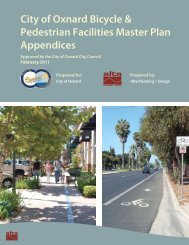Santa Clara River Trail Final Master Plan - Development Services ...
Santa Clara River Trail Final Master Plan - Development Services ...
Santa Clara River Trail Final Master Plan - Development Services ...
Create successful ePaper yourself
Turn your PDF publications into a flip-book with our unique Google optimized e-Paper software.
<strong>Santa</strong> <strong>Clara</strong> <strong>River</strong> <strong>Trail</strong> <strong>Plan</strong><br />
<br />
<br />
<br />
Diverting water in a stream channel<br />
Catching and relocating steelhead<br />
Grouting rip-rap<br />
CDFG<br />
Streambed Alteration Agreement: If your project includes alteration of the bed, banks or channel of a<br />
stream, or the adjacent riparian vegetation, then you may need a Streambed Alteration Agreement from<br />
the California Department of Fish and Game (CDFG). The California Fish and Game Code, Sections<br />
1600-1616, regulates activities that would alter the flow, bed, banks, channel or associated riparian areas<br />
of a river, stream or lake—all considered “waters of the state.” The law requires any person, state or local<br />
governmental agency or public utility to notify CDFG before beginning an activity that will substantially<br />
modify a river, stream or lake.<br />
Two forms are required in the SAA application packet:<br />
“Notification of Lake or Streambed Alteration” form (FG 2023)<br />
“Project Questionnaire” form (FG 2024)<br />
These forms are available at www.dfg.ca.gov/1600/notification_pkg.html<br />
Section 2081 Incidental Take Permit. The California Department of Fish and Game (CDFG) will<br />
require a Section 2081 Incidental Take Permit if a project has the potential to negatively affect stateprotected<br />
plant or animal species or their habitats, either directly or indirectly. Protected species include<br />
those “listed” by the state as endangered or threatened. Besides listed species, there are other categories<br />
of species protection, including “fully protected” and California Species of Special Concern (CSC).<br />
Adverse impacts to species that have the “fully protected” designation are prohibited.<br />
RWQCB<br />
A RWQCB 401 Certification is triggered whenever a USACE 404 Permit is required, or whenever<br />
an activity could cause a discharge of dredged or fill material into waters of the U.S. or wetlands.<br />
In California, the state and regional water boards are responsible for certification of activities<br />
subject to USACE Section 404 Permits. The RWQCB “Section 401 Water Quality Certification<br />
Application Form” is used and is located with directions at<br />
www.waterboards.ca.gov/losangeles/html/meetings/401wqc.html.<br />
The RWQCB Solid Waste Division also manages Waste Discharge Requirements for these landfills.<br />
SWRCB<br />
Construction General Permit: The State Water Resources Control Board (SWRCB) administers a<br />
statewide general permit, called a Construction General Permit, to cover a variety of construction<br />
activities that could result in wastewater discharges. <strong>Development</strong> and implementation of a Storm Water<br />
Pollution Prevention <strong>Plan</strong> (SWPPP) is required as part of the permit.<br />
City of Oxnard | 61
















